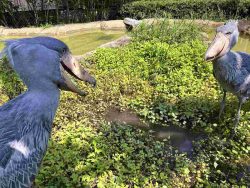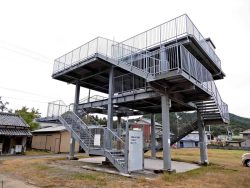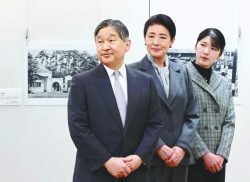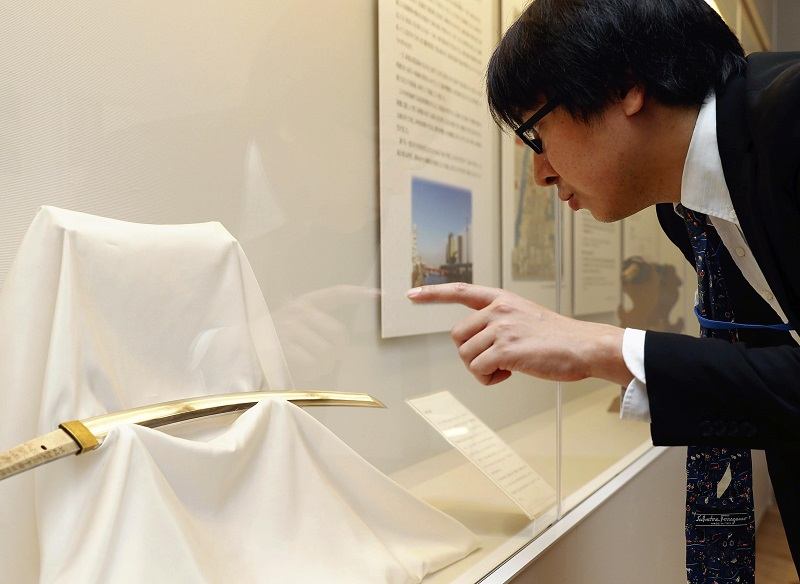
Fumito Arakawa of the Japanese Sword Museum explains the features of a sword on display on the Sumida Ward, Tokyo, facility’s first floor, which is open to the public free of charge.
9:18 JST, July 6, 2022
Japanese swords that change color depending on the light source, setting and viewing angle are delighting visitors at the Japanese Sword Museum in Tokyo.
The museum is situated in a corner of the Kyu-Yasuda Garden, not far from the Ryogoku Kokugikan sumo stadium in Sumida Ward, after relocating from Tokyo’s Shibuya Ward in 2017.
The building, designed by renowned architect Fumihiko Maki, incorporates physical features of the Ryogoku Kokaido public hall, which once stood on the same site before being demolished in 2015.
The circular exterior of the building that extends toward the pond is a distinctive feature of its design. The first floor of the facility is open to the public as a place for visitors strolling through the garden to have a respite.
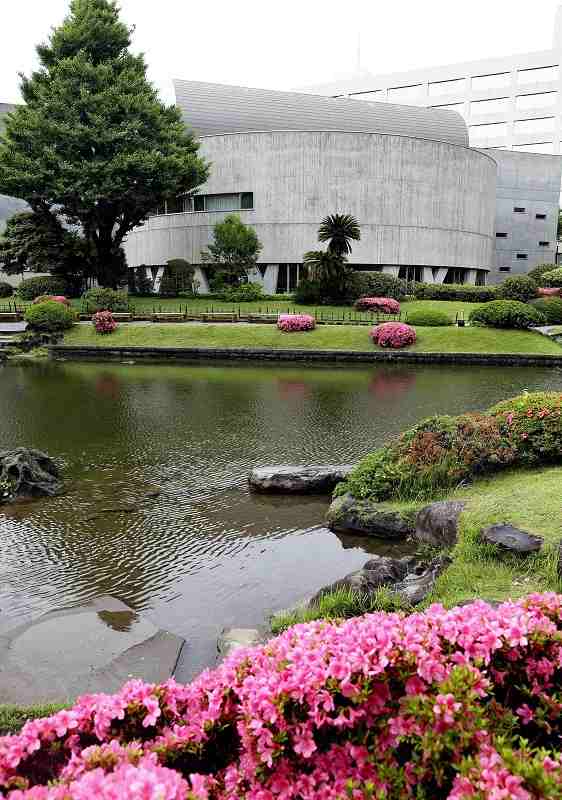
The museum is located in a corner of the Former Yasuda Garden.
The museum operator, the Society for Preservation of Japanese Art Swords, was established after World War II to safeguard the country’s swords as artworks because Japan feared occupation forces would confiscate them to use as weapons.
The facility features a collection of about 400 swords, including three designated as national treasures and seven chosen as nationally important cultural properties. One of the three is “Rai Kuniyuki,” made in the Kamakura period (late 12th century to 1333).
Some of the items belonged to warlords such as Uesugi Kenshin and Date Masamune.
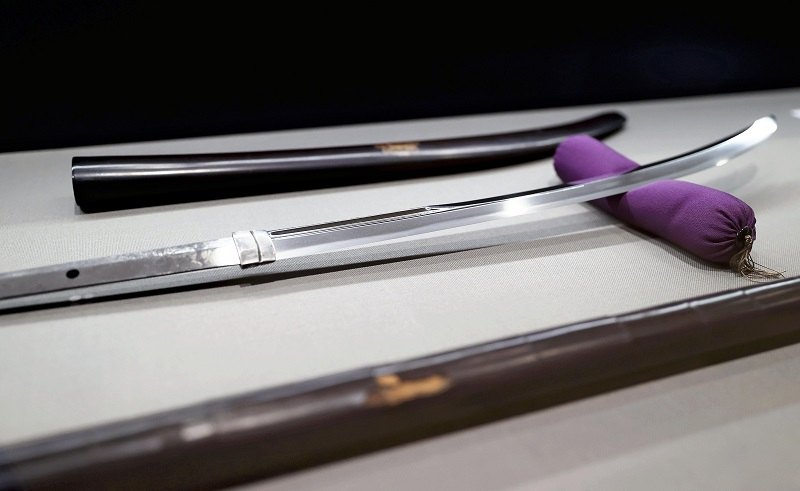
One of the swords on display at the Japanese Sword Museum in Sumida Ward, Tokyo.
The museum features different exhibits five to six times a year in its third-floor showroom. In addition to special exhibitions on themes such as blade patterns, there are also shows that focus on swords and their accessories, which are comparable to important cultural properties that have passed the association’s screening.
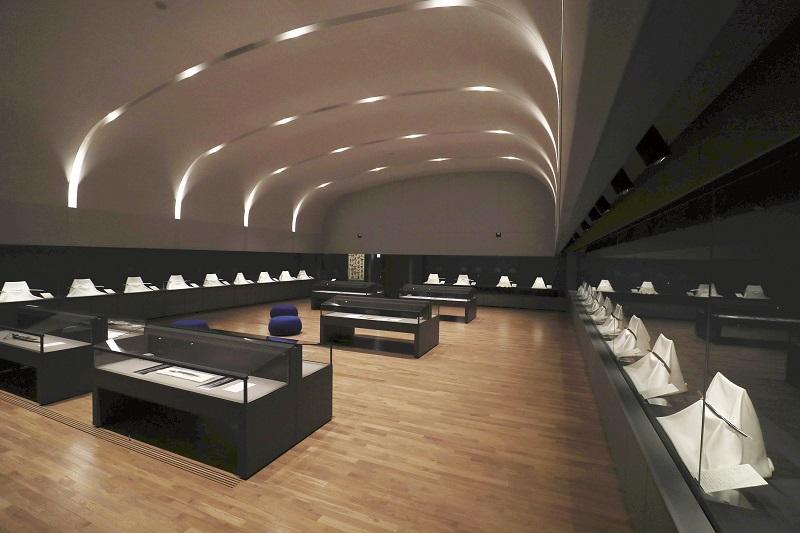
About 40 swords are on display on the third floor of the museum.
Events also include a competition among contemporary craftsmen in the form of an exhibition.
Influenced partly by a video game featuring anthropomorphic Japanese swords, a recent trend has seen an increase in the number of female visitors who are fascinated by the weapons.
Also popular at the museum are lectures on sword etiquette, during which visitors learn how to handle and appreciate the weapons by holding them in their own hands, with more than half of the participants being women.
Fumito Arakawa, 35, curator of the museum, welcomes the new demographic.
“In the past, many of the visitors were older men. Now, many women come to our museum after starting to play the game. They have become interested in the exhibition and its themes, and now are frequent visitors,” Arakawa said.
Japanese swords change appearance, depending on the lighting and the angle from which they are viewed, he said.
According to Arakawa, there are three main points in the appreciation of Japanese swords: the shape, which is the beauty of the overall form; the shaft of the blade, which is crafted by folding raw steel made by repeatedly smelting iron sand; and the blade pattern, which is created by a swordsmith using a variety of techniques.
“I want people to view swords as they are, and discover what they like about them without first filling their heads with too much information,” Arakawa said.
Japanese Sword Museum
The museum was opened in Shibuya Ward, Tokyo, in 1968 to preserve and exhibit Japanese swords and to promote the country’s sword culture. It subsequently moved to its current location.
Address: 1-12-9 Yokoami, Sumida Ward, Tokyo
Hours: 9:30 a.m.-5 p.m. (closed Mondays)
Admission: Adults ¥1,000, students ¥500, junior high school students and younger free
Related Tags
"Features" POPULAR ARTICLE
-

Sanrio to Open Museum in Yamanashi Pref. Dedicated to Founder, Exhibits Include Hello Kitty, Other Characters
-

Autumn Foliage Surrounds Visitors to Tokyo’s Showa Kinen Park
-

My Daughter No Longer Speaks to Me, But I Want to See Her and My Grandchild
-

Kumamoto: Public Bath Refurbished as Library Where You Can Chat, Take Photos
-
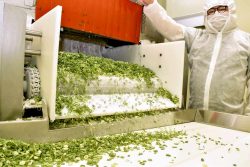
Frozen Vegetables: Demand Rises for Convenient, Tasty Domestic Produce
JN ACCESS RANKING
-

Tokyo Economic Security Forum to Hold Inaugural Meeting Amid Tense Global Environment
-

Keidanren Chairman Yoshinobu Tsutsui Visits Kashiwazaki-Kariwa Nuclear Power Plant; Inspects New Emergency Safety System
-

Imports of Rare Earths from China Facing Delays, May Be Caused by Deterioration of Japan-China Relations
-

University of Tokyo Professor Discusses Japanese Economic Security in Interview Ahead of Forum
-

Japan Pulls out of Vietnam Nuclear Project, Complicating Hanoi’s Power Plans



